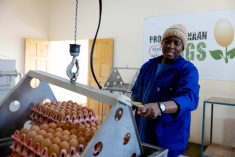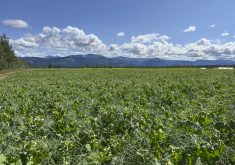Increased consumer interest in food systems could lead to new markets for farmers and food processors.
Structural changes in the food sector have had significant impact on demand for agriculture goods, but the question is whether those changes will be long term or temporary.
A series of conversations at Canada’s Digital Farm Show focused on the future of food in the pandemic area.
Why it matters: Optimism for the future could serve as inspiration for farmers to persevere through any struggles they’re encountering now due to COVID-19.
Read Also

Ontario’s agri-food sector sets sights on future with Agri-Food 2050 initiative
The first-ever Agri Food 2050, a one-day industry event dedicated to envisioning the future of food and farming in Ontario,…
Dalhousie University’s Sylvain Charlebois, University of Guelph’s Evan Fraser, and the food marketing duo of Len Kahn (Kahntact Communications) and Jo-Ann McArthur, Nourish Food Marketing, were in three separate conversations with Laura Rance, Vice-President of Content for Glacier FarmMedia.
In the pandemic’s early days, Charlebois noted, the ratio of food service purchases versus retail purchases of food went from 40:60 to 9:91. With this huge shift to at-home consumption, McArthur said, “consumers started to google ‘food supply’ and ‘food system’ – words they never would have thought about before.” Why? Because it turned out the weakest link in the food system was in food processing, which couldn’t shift quickly enough to provide sufficient destined-for-retail products. And empty store shelves were the result.
“Our resiliency probably wasn’t as strong as we’d thought,” McArthur said.
Fraser, though, says some of the surprises weren’t really surprising at all. The “just-in-time” model driving an increasingly consolidated food processing sector, particularly in meat packing, should in retrospect have had more built-in resilience. Fraser cited the creator of a podcast he heard recently, in which an alternative, more resilient, model was proposed – dubbed a “just-in-case” model.
And in another predictable weakness, Canada began allowing temporary foreign workers into the country under certain restrictions way back in 1960 “as a stop-gap measure” to address a perceived farm labour shortage. Fraser, who grew up on a horticulture operation in Niagara Region, noted, “60 years later, we are structurally dependent on it.”
Long-term or short term trends?
The Digital Farm Show discussions proved, however, that COVID-related brain-storming in the agricultural sector has now moved well beyond identifying those weaknesses, towards contemplating how farmers can emerge with strength in the pandemic’s wake.

Charlebois explained the food-retail-to-food-service ratio now sits at 78:22, and predicted it will eventually settle at 70:30. This alone should energize the agricultural sector, since “the more people spend in food retail versus food service, the more money comes back to farmers.”
On the other hand, massive job losses in the hospitality sector can’t go unnoticed. McArthur sees two huge groups of Canadians whose fortunes have been affected in very different ways by COVID-19.
The first are those with no kids, who are no longer commuting to work, and no longer spending a significant amount of their discretionary income dining out or consuming live music/theatre. They can easily and comfortably take the extra time and spend the extra money on direct-from-farmer purchases.
The second group, though, had jobs in hospitality or other severely affected sectors, is finding it very difficult to return to work due to lack of prospects and increased childcare responsibilities, and is now using food banks more often.
Still others, meanwhile, aim to capitalize on “the new normal” of pandemic-era eating. McArthur believes the developing trends of buying Canadian and eating local have now been “put on steroids,” and opportunities abound for those able to make the right types of connections with consumers.
Innovative methods for fostering these connections have already surfaced; Charlebois cited “ghost kitchens” – ready-for-pickup, restaurant-style food preparation, minus the seating areas – on the outskirts of major urban areas, providing an almost direct link between farmers and popular dine-at-home apps like Skip the Dishes and Uber Eats.
If governments are able, in keeping with their lofty commitments, in making rural high-speed internet ubiquitous, Kahn says tekkie entrepreneurs will find even more creative ways for farmers to circumvent the middle-men of distribution and retail.
There will be opportunities, too, in food processing and in the mechanization of fruit and vegetable production. Decades ago, Canada was at the forefront of these industries, but no more; without strong government support, food processing was gradually lost to countries with cheaper labour and fewer regulations, while mechanization slowed because it was more economical to keep alive the “stop-gap” temporary foreign worker model.
In both cases, though, investment from Canadian governments is crucial. And, Fraser noted, when it comes to replacing off-shore labour with technology in orchards, vegetable farms and greenhouses, it’s crucial that Canadian governments turn their foreign aid budgets towards helping create meaningful, gainful employment for those families in their home countries.
That’s just one reminder of the sacrifices Canadians may be asked to make as they climb away from the pandemic’s slowdown. “The mask is a very visual emblem of the compromise we’ll have to make here,” Charlebois mused. Food prices will rise, as will publicly funded support for those who can’t pay those prices. It’s hoped that food banks won’t be a stop gap measure.
McArthur is optimistic Canadians will accept compromises. She says that consumers’ focus in the months following the panic-buying of March and April, shifted away from at-home food preparation skills to be more on health, healthy foods such as fresh vegetables, and decreasing food waste.
But Fraser says it’s imperative that governments and agri-food stakeholders “get ahead of these trade-offs” and prepare a truly effective national food policy that takes in not only Canadians but also others, globally, affected by their food consumption. “Because even a couple of years of bad food insecurity can set a whole generation back.”















